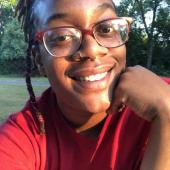This is not that play

When I heard that a play I’ve adored since my adolescence: For Colored Girls Who Have Considered Suicide/When the Rainbow is Enuf by Ntozake Shange was being produced at Penumbra Theatre Company, the place that helped to nurture my passion and devotion to theatre, ‘excited’ really could not capture the feeling. And in many ways this production did not disappoint. From a predominantly female technical team, the inimitable Ananya Chatterjea of Ananya Theatre, as the choreographer; to the modernizing twist featuring Futures, 1, 2, and 3 as an offering to our young; this production proved that Shange’s work has truly stood the test of time. Nonetheless, I did find myself disappointed that the cast was not an all-black female cast, given the contextual and cultural specificity that Shange created within the language of this choreopoem.
Cardi B and Futures 1, 2, 3
The production begins with the gathering of three young black girls to the ambient sounds of a playground in use. The girls share their favorite songs, dance moves, and laughter. It is the glimpse of young sisterhood that encourages young women that their greatest strength is in their togetherness. In a world where fun loving and hilarious rapper Cardi B is constantly being compared to rapper Nicki Minaj, especially after their New York Fashion Week scuffle, it is refreshing to be reminded that women do not need to be competitors and instead of engaging in petty conflicts, can be sisters. Even more, the eldership created at the end of the choreopoem, where each of the seven women surround the three girls in a circle of sand, reiterates how the power each grain of our lives has in protecting and encouraging our youth. This unrestricted love between women is a necessary aspect of the emotional, psychological, and spiritual wellbeing for women and girls to step into the best versions of themselves.
And Yes, Women are Tech’s Too
And the women of the technical team certainly brought the best of themselves in creating the worlds that this choreopoem explores. The women of the technical team: Drea Reynolds, on sound, long standing stage manager for Penumbra, Mary Winchell, set designer Vicki Smith, Kathy Maxwell on lights, Kiara Jackson as the assistant costume designer, and Abbee Warmboe on props is definitely one of the most female technical teams theatre anywhere has seen. Technical theatre is generally an incredibly white male dominated field within the realm of theatre, also one the highest paying, so to see a production with so many women apart of the technical team is a groundbreaking historic moment for American Theatre.
Black Women, Women of Color, and When We Converge
Loretta Ross offers an explanation of the history of the term ‘women of color.’ During the National Women’s Conference in 1977 a group of black women from Washington, D.C. came to the conference in Houston with a document called the Black Womens’ Agenda, due to the inadequacies of the conference to meet the needs of ‘minority women.’ Other ‘minority women’ wanted to be apart of their movement to decolonize women’s movement work. The black women agreed, but it could no longer be called the Black Womens’ Agenda, thus the term women of color was born.
I set this history to say that I certainly see the power in sisterhood with non-black women of color. I’ve experienced it throughout my life and it has been enriching to understand how our differences and similarities converge. However, I deem it irresponsible to cast For Colored Girls Who have Considered Suicide/When the Rainbow is Enuf without an all-black female cast because it purports that there is not diversity among black women and it brings people into a cultural and linguistic territory that they do not have the cultural upbringing to represent.
Certainly, as a black woman, I would never erase the voice of a Asian American or Non-Black Latino sister by representing her culture. Our cultural boundaries can be preserve our uniqueness, our beauty, and still not be violent. Though Sun Mee Chomet, Audrey Park, and Cristina Florencia Castro are all very capable and wonderful performers, there are black women who are Latino and have Asian American heritage that would have shown more comfort on stage speaking versions of ebonics, handling the trauma behind n****r, and participating in hoodoo/voodoo ritualistic representations on stage.
There is certainly a play where women of color gather to speak about our collective and unique experiences, I am eager to see it, eager to know if it already exists, and if not, eager to learn of its creation. This production does show that there is a need for such a play. But For Colored Girls Who have Considered Suicide/When the Rainbow is Enuf is not that play.




